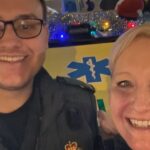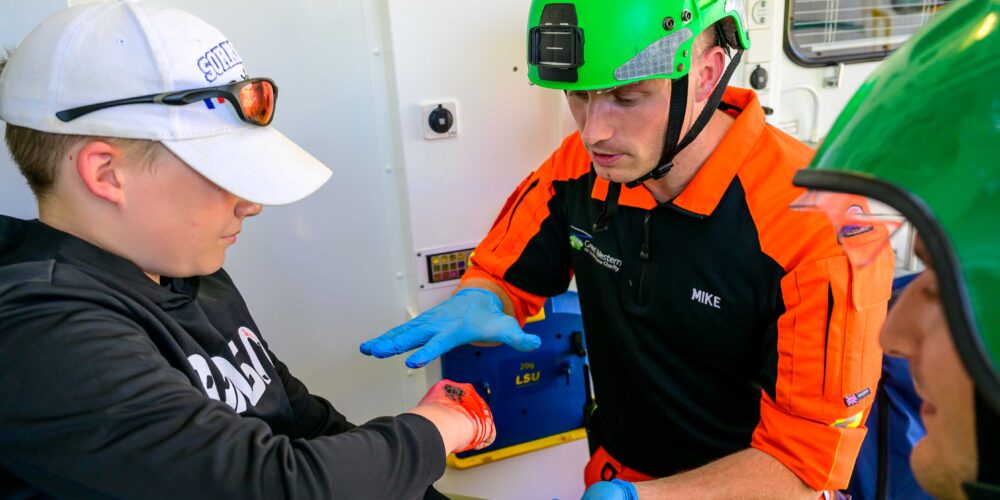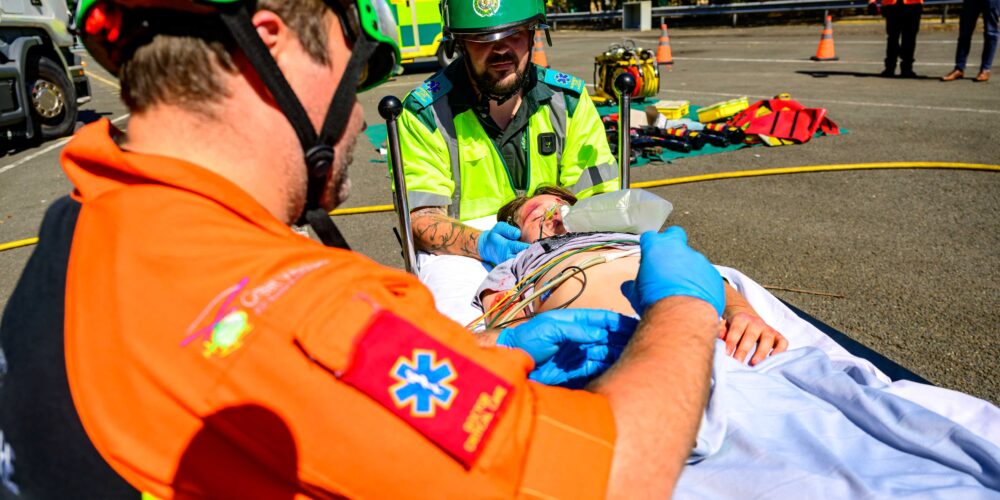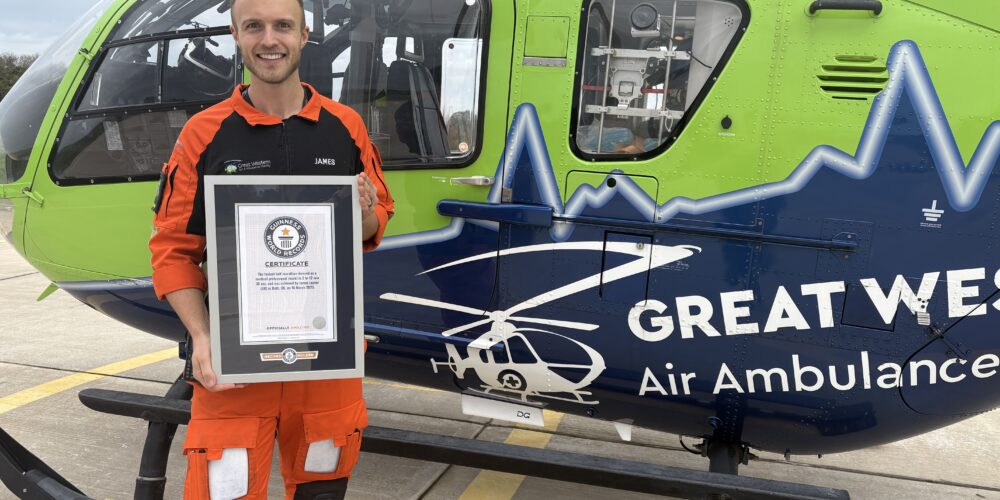
Q&A’s with Heartstarters Volunteer and aspiring Critical Care Paramedic, Zoe Boswell
April 8, 2025
Dare the Drop 2025 – In pictures
May 9, 2025“Today, I am back enjoying all the things I did before my cardiac arrest, thanks to the Great Western Air Ambulance Charity Team and everyone who helped me that day.”
On 12 September 2024, Rhiannon, a 39-year-old accountant from Bristol, had just finished a work call at home when she collapsed on the floor.
Rhiannon’s husband Dan had just got in from work. He said, “I heard a strange noise and a crashing sound in the study. I called out but got no response. I found Rhiannon on the floor on her side. I rolled her onto her back and she wasn’t breathing. I checked her pulse and couldn’t feel one.” Dan phoned 999. He said, “I wasn’t panicking at this point; the panic set in when the call handler was talking me through CPR. It felt like hours, but after eight or nine minutes they said to open the front door to the paramedics. It was scary to walk away from Rhiannon and open the front door, but I knew I had to.”
Dan remembers that two paramedics arrived in an ambulance followed by other emergency response vehicles but says, “It was all a bit of a blur after that.”
GWAAC crew rush to help
When the call came in, Critical Care Doctor Julian Thompson and Specialist Paramedic in Critical Care (SPCC) Mark Kinsella jumped in one of GWAAC’s fully equipped cars and set off through the Bristol rush hour traffic.
SPCC Mark said, “We had an update from the Helicopter Emergency Medical Service desk en route so we knew Rhiannon had been given a number of defibrillator shocks by the ambulance crew. This helped us plan what we needed to do when we got there.”
When the GWAAC Team reached Rhiannon, they put a breathing tube in to secure her airway and fitted the LUCAS machine (Lund University Cardiopulmonary Assist System) to give her automatic chest compressions. SPCC Mark explains, “It’s a bit of kit that you don’t find in normal ambulances. It’s good for when a patient is in a tight place and Rhiannon was in a small room with six or seven people; it was quite cramped.”
They also placed an arterial line into Rhiannon’s artery to receive instant information about her blood pressure which they used to tailor treatment at the scene.
SPCC Mark and Dr Julian changed the position of the defib pads for better direction, put Rhiannon onto a stretcher and put her in the ambulance. Dr Julian made a phone call to the Bristol Royal Infirmary so the team there could get ready to receive her; it was the best hospital for Rhiannon’s needs because it’s home to the Bristol Heart Institute.
Teamwork at the scene made all the difference
SPCC Mark said, “The average ambulance crew might see a patient in cardiac arrest once every six months whereas the GWAAC crew can be called to help several cardiac arrest patients in one day. The ambulance crew had done a great job of managing the situation before we got to Rhiannon – something that could be due to the enhanced training we’ve been providing to paramedics through our Outreach programme. What they did that day for Rhiannon made it easy for us to begin our treatment without wasting valuable time.” And of course, the ambulance crew could only do what they did because of Dan’s quick and calm reactions, calling 999 and giving lifesaving CPR. Rhiannon says, “I have no idea how Dan kept it all together, but without him I wouldn’t be here today!”
On the way to hospital, Rhiannon’s heart rhythm suddenly changed. In the back of the ambulance, SPCC Mark and Dr Julian administered adrenalin and fluids and continued with resuscitation to get her heart rhythm stable. On arrival, the GWAAC team wheeled Rhiannon from the ambulance into the hospital and handed her over to the waiting consultant and team. The consultant was GWAAC’s Critical Care Doctor Matt Thomas — all of GWAAC’s doctors work as consultants in hospitals across GWAAC’s region and beyond.
SPCC Mark said, “We’ll never be sure why Rhiannon had a cardiac arrest; it’s uncommon for a woman in her thirties to have one. The most usual reason is a blood clot to the artery, but Rhiannon had clear arteries so we knew there must have been another medical reason.”
The days afterward
Rhiannon, who has no recollection of the day of her cardiac arrest, says, “I don’t even remember the first time I woke in hospital or breathing on my own. But that’s fine by me. The human brain is very clever and I believe this is its way of protecting me from reliving the trauma, so I am very much OK with that.”
Rhiannon does remember seeing the GWAAC Team a few times in hospital while she was recovering. She says, “It was really great to see them when they popped in to say hello and check how I was doing. It was good to hear about what they did to help that day and I know all my family were pleased to get the chance to say thank you too!”
SPCC Mark was keen to monitor Rhiannon’s recovery in hospital because she was one of the first patients that the GWAAC Team had transferred to hospital while still in cardiac arrest. SPCC Mark said, “I’m in a working group for moving patients in cardiac arrest. Rhiannon was my third patient recruited – historically, we wait until we’ve achieved return of spontaneous circulation (ROSC) then we’ll move the patient to hospital. The aim of the working group is to speed up the time to hospital and the patient’s vital ongoing treatment.” He was even present during her defibrillator insertion surgery.
Despite lots of tests in hospital, it is still unclear why Rhiannon suffered a cardiac arrest, but the ICD (Implantable Cardioverter Defibrillator) device was fitted just in case; Rhiannon calls it her “insurance policy” in case it does ever happen again.
17 days after being wheeled into the emergency department, Rhiannon was allowed home. She remembers her neighbour giving her a big hug and saying, ‘I can’t believe I’m able to do this.” Everyone on the street thought the ambulances were for their 80-year-old neighbour, not for Rhiannon.
Visiting the crew at GWAAC’s airbase
While in hospital, SPCC Mark had invited Rhiannon and Dan to visit GWAAC’s airbase and learn more about the charity’s operations when they felt ready. Five months later Rhiannon was, “very much looking forward to seeing everyone.”
Rhiannon and Dan were greeted by a warm welcome from SPCC Mark and Supporter Engagement Coordinator, Eloise. They answered Rhiannon and Dan’s questions about the service GWAAC provides and SPCC Mark explained how the crew gets dispatched following a 999 call. After a tour of the airbase and a meet-and-greet with the crew on shift, SPCC Mark asked Rhiannon and Dan if they wanted to learn more about how the GWAAC Team helped Rhiannon that day. The couple said yes, so SPCC Mark showed them the equipment that Dr Julian and himself had used to keep Rhiannon alive, including a demo of the LUCAS machine.
SPCC Mark told Rhiannon, “It was only because of Dan’s chest compressions, which kept your heart pumping blood and got oxygen to your brain, that the paramedics and us were able to provide that next level of treatment.” He said, “Dan made a catalogue of good decisions that day.”
Rhiannon said, “Dan had a tougher time than me, doing the chest compressions and living through it.” Dan recalled, “I had it in the back of my head – I can’t make this worse. I’ve got to do something.”
Dan expressed his surprise at how integrated into the healthcare system GWAAC is and yet receives no government funding. Mark described GWAAC’s service as, “The pre-hospital enhancement to your care outside the NHS, and it wouldn’t be possible without the support and donations received from people in our local communities.”
Rhiannon and Dan also said they were surprised that an air ambulance service would come out to them in the middle of the city. Dan said, “It didn’t even occur to me that you would come in a car. When I heard you had arrived, I asked: ‘Where did you land?’ I just didn’t realise that you helped people in the city – I thought air ambulances were more like a Search and Rescue service.”
“The more I learned about what happened, the more grateful I became…”
Rhiannon says, “My gratitude to my husband, to GWAAC and to all of the emergency services, nurses, doctors and surgeons who took care of me remains with me, as well as the love I felt from my friends and family who were with me every day in the hospital. They made it so much less lonely and so much easier to recover.”
Rhiannon is grateful to be back home and living a normal life. She believes she made a quick recovery partly because she was lucky, partly because she is strong-willed and because she had excellent care. She said, “I also had lots of friends and family praying for my recovery.”
Six months on from her cardiac arrest, Rhiannon said, “It definitely feels time to focus on the future now. There are still some more tests to do but ultimately it’s likely the cause of my cardiac arrest will always be an unknown. But I have my defib which should mean I will be fine to do just about anything I choose!”
In December Rhiannon and Dan welcomed a new puppy into their home: “He is proving to be a wonderful distraction for myself, my husband and our 16-year-old dog too!”
And in early 2025, Rhiannon signed up to do GWAAC’s Dare the Drop on 4 May – a 75ft abseil from the roof of the Dolman Stand at Ashton Gate Stadium in Bristol. Before the event, she said, “It just feels like a must! It’s my way of saying a huge thank you, but I’m really not sure that covers it. And thanks to very generous family, friends and colleagues (both mine and Dan’s), the fundraising is going well.”
Rhiannon even encouraged three of her family to do it with her. They filled the first slot of the day and were looking forward to dropping down beside the pitch with GWAAC’s SPCC Callum Sutton. Rhiannon said, “For anyone thinking about doing the abseil, it’s just got to be, do it! There’s not going to be a better cause. The air ambulance and everything around it is so important and something people aren’t aware of unless GWAAC has touched their lives.”
Dan adds, “We are incredibly grateful for the swift and lifesaving response of the GWAAC Team. SPCC Mark and Dr Julian were instrumental in Rhiannon’s survival, and their expertise and dedication made an immeasurable difference during that critical time.”
Find out more about what we do to care for the hearts in your community.
"The average ambulance crew might see a patient in cardiac arrest once every six months whereas the GWAAC crew can be called to help several cardiac arrest patients in one day."

"It was really great to see them when they popped in to say hello and check how I was doing. It was good to hear about what they did to help that day and I know all my family were pleased to get the chance to say thank you too!"

"It didn’t even occur to me that you would come in a car. When I heard you had arrived, I asked: ‘Where did you land?’ I just didn’t realise that you helped people in the city – I thought air ambulances were more like a Search and Rescue service."

“It was only because of Dan’s chest compressions, which kept your heart pumping blood and got oxygen to your brain, that the paramedics and us were able to provide that next level of treatment."
“It was such a fun day! Climbing over the bar on the roof was definitely nerve wracking but what a thrill to actually dare the drop - by the time my feet were on the floor I could have done it all over again”





